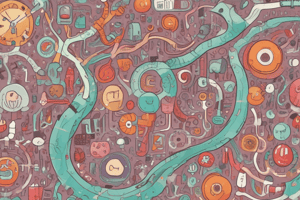Podcast
Questions and Answers
What is the primary function of amino acids in the cell?
What is the primary function of amino acids in the cell?
- As a regulator of gene expression
- As a source of energy for the cell
- As a component of the cell membrane
- As building blocks for protein and peptide synthesis (correct)
What happens to surplus amino acids in the cell?
What happens to surplus amino acids in the cell?
- They are stored in the cell for later use
- They are used as metabolic fuel (correct)
- They are excreted from the cell
- They are converted into fatty acids
What is the primary fate of the amino groups of surplus amino acids?
What is the primary fate of the amino groups of surplus amino acids?
- They are converted into urea (correct)
- They are converted into fatty acids
- They are converted into ketone bodies
- They are converted into glucose
What type of reactions are involved in the redistribution of amino groups among amino acids?
What type of reactions are involved in the redistribution of amino groups among amino acids?
What is the role of pyridoxal phosphate in transamination reactions?
What is the role of pyridoxal phosphate in transamination reactions?
What is the main function of the urea cycle in amino acid catabolism?
What is the main function of the urea cycle in amino acid catabolism?
What is the fate of the carbon skeletons of surplus amino acids?
What is the fate of the carbon skeletons of surplus amino acids?
How are amino acid levels regulated in the cell?
How are amino acid levels regulated in the cell?
What is the role of glutamate in amino acid metabolism?
What is the role of glutamate in amino acid metabolism?
What is the result of the catabolism of amino acids?
What is the result of the catabolism of amino acids?
Flashcards are hidden until you start studying
Study Notes
Transamination Reactions
- Transamination reactions involve the α-ketoglutarate/L-glutamate couple as an amino group acceptor/donor pair.
- The specificity of a particular transaminase is for the amino group other than the glutamate.
- All amino acids except lysine, threonine, proline, and hydroxyproline participate in transamination reactions.
- Transamination of an amino group not at the α-position can also occur.
Biosynthesis of Amino Acids
- The carbon skeletons of 10 amino acids are derived from intermediates of glycolysis and the TCA cycle.
- As amino acid levels increase, a key biosynthetic enzyme is allosterically or transcriptionally inhibited to maintain amino acid levels.
- The aminoacyl-tRNA synthetases can remain active at these maintained levels.
Synthesis of Nonessential Amino Acids
- Transamination reactions involve pyridoxal phosphate (PLP) and another amino acid/α-keto acid pair.
- The α-amino group of most amino acids comes from the α-amino group of glutamate by transamination.
- Glutamine contributes its side-chain N atom in the biosynthesis of tryptophan and histidine.
- Glutamine carries NH3 from peripheral tissues to the kidney, where the amide N is hydrolyzed by the enzyme glutaminase.
Transamination
- Transamination of pyruvate to form alanine occurs.
- Transamination of oxaloacetate to form aspartate occurs.
- Asparagine aminotransferases (also known as transaminases) transfer amino groups via enzyme-associated intermediates derived from pyridoxal phosphate.
- Pyridoxal phosphate is linked to the enzyme by formation of a Schiff base between its aldehyde group and the ε-amino group of a specific lysyl residue at the active site.
Oxidative Deamination
- The nitrogen atom transferred to α-ketoglutarate in the transamination reaction is converted into free ammonium ion by oxidative deamination.
- This reaction is catalyzed by glutamate dehydrogenase.
- The reaction proceeds by dehydrogenation of the C-N bond, followed by hydrolysis of the resulting Schiff base.
Nitrogen Transport
- Ammonia formed in muscle and other extrahepatic organs is transported through the blood circulation in nontoxic form as amino acids, predominantly glutamine and alanine.
- The main destination of blood alanine is the liver, where ammonia is released by transamination and by action of glutamate dehydrogenase.
- Some glutamine is also transported to the liver, some is taken up by the kidneys and ammonia is released, protonated to ammonium ion, and excreted.
Amino Acid Catabolism
- Amino acid catabolism is the sequence of enzyme-catalyzed reactions by which relatively large molecules in living cells are broken down, or degraded.
- Amino acids in excess of those needed for biosynthesis cannot be stored, but are instead used as metabolic fuel.
- The α-amino group is removed, and the resulting carbon skeleton is converted into a major metabolic intermediate.
- Most of the amino groups of surplus amino acids are converted into urea through the urea cycle, whereas their carbon skeletons are transformed into acetyl CoA, acetoacetyl CoA, pyruvate, or one of the intermediates of the citric acid cycle.
Studying That Suits You
Use AI to generate personalized quizzes and flashcards to suit your learning preferences.




